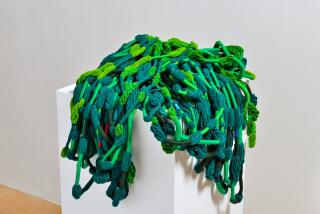Sculptor of light and air
- Share via
San Francisco — SHE studied with masters amid America’s Modernist ascendancy and while a student garnered attention in Time magazine. At 24, she showed in a San Francisco Museum of Modern Art group exhibition and four years later, in 1954, had her first solo show in New York. That precipitated a review in Time, the cover of Arts & Architecture, purchases by collectors including the Rockefellers and Philip Johnson, and inclusion in shows at the Whitney Museum of American Art, Chicago Art Institute and Museum of Modern Art in New York. But for many visitors, “The Sculpture of Ruth Asawa: Contours in the Air” at the de Young Museum through Jan. 28 will be the first glimpse of work by an 80-year-old sculptor who deserves to be counted among such contemporaries as Louise Nevelson, Isamu Noguchi and David Smith.
This first full survey -- which travels to the Japanese American Museum in Los Angeles March 10 through May 27 and to the Japan Society in New York in the fall -- aims to function as a corrective, and it does so with a wallop.
Retrospectives often benefit from the artist already being well known. This show had to do more heavy lifting in providing background via documentary material, including photos shot in Asawa’s studio by her friend Imogen Cunningham. The result is engaging without being overpowering. The same can be said of the catalog, which mingles fine reproductions with interviews with Asawa and her husband, architect Albert Lanier, and essays that are both scholarly and accessible. But among many things the exhibition does well, what it does best is let its 44 works on paper and 52 sculptures, many of them in Asawa’s signature crocheted wire, speak for themselves.
Asawa was born in Norwalk, the fourth of seven children of Japanese immigrant parents. She grew up on a family farm until 1942, when her father was arrested and interned in New Mexico along with other immigrants from Japan. The rest of the family was moved to stables at the Santa Anita racetrack, where Ruth learned drawing from interned Japanese artists who had worked at Disney Studios. The family was relocated again to Arkansas, where she completed high school.
Offered a one-way ticket to any college not near a coast, she chose the Milwaukee State Teachers College. But there she was told that nobody in Wisconsin would hire a Japanese American teacher, and she never obtained the credentials necessary for her bachelor’s degree. In 1946, inspired by a glimpse of Modern art caught while traveling in Mexico City, she headed for Black Mountain College in North Carolina. There she studied with visionary teachers, including Josef Albers, Merce Cunningham and Buckminster Fuller, and met Lanier, with whom she settled in San Francisco in 1949.
Influenced by Fuller’s concerns with structure and ecology and enveloped in Albers’ preoccupations with transparency, negative space and reductive composition, Asawa began to experiment with crocheting wire. The method yielded fluid forms with structure and surface mutually defining one another via a repetitive, loopy line with just enough strength to hold a shape when suspended.
With their flowing and pulsing repetitions of forms -- bells, cones, teardrops, spheres, undulating ruffles -- these sculptures aggressively define the space around them, cutting the air into silhouettes while passively submitting to space and allowing it to flow through them. You see all of the sculpture from every angle, experience every curve as a concavity and convexity, and have a simultaneous sense of being within and without. When forms are in close proximity or when one is contained within another, gradations of transparency occur. As you move around them, shifting relationships among layers of crocheted wire or between the sculptures and their lacy shadows generate moire effects and dazzling plays of material, light and shadow that recall the light-refracting surface treatments David Smith employed at about the same time. The pieces also prefigure Robert Morris’ 1960s experiments with mesh and mirrors as sculpting materials.
Other works in the exhibition range from early drawings and paintings to later sculptures made by bundling and twisting wire, to recent works in bronze cast from structures originally created in wire and wax or folded paper. These share many traits with the crocheted works: an emphasis on harmony, plays on connectedness, a mingling of the organic and mechanical, and a sense of codependence between the tiny incident and larger scenario. Such are both the literal qualities and the implications of Asawa’s works.
For those who don’t believe in the evocative power of form, and for those who do, this exhibition will be an education.
More to Read
The biggest entertainment stories
Get our big stories about Hollywood, film, television, music, arts, culture and more right in your inbox as soon as they publish.
You may occasionally receive promotional content from the Los Angeles Times.










